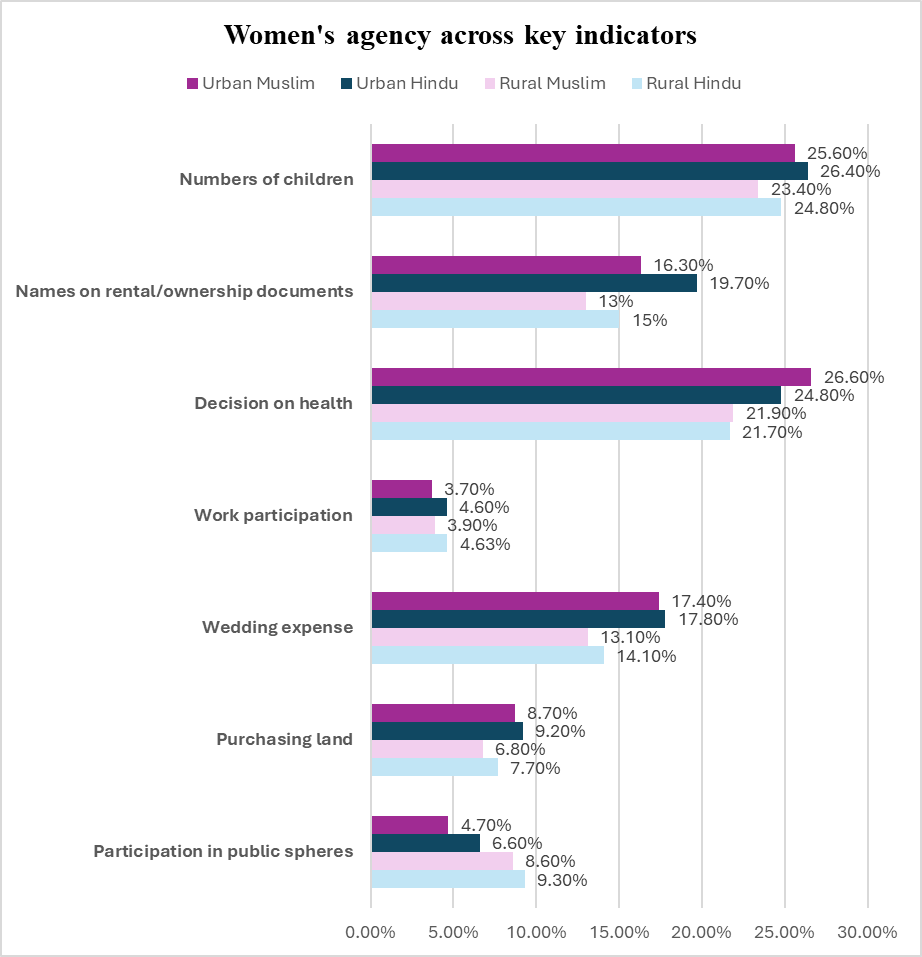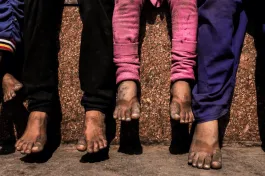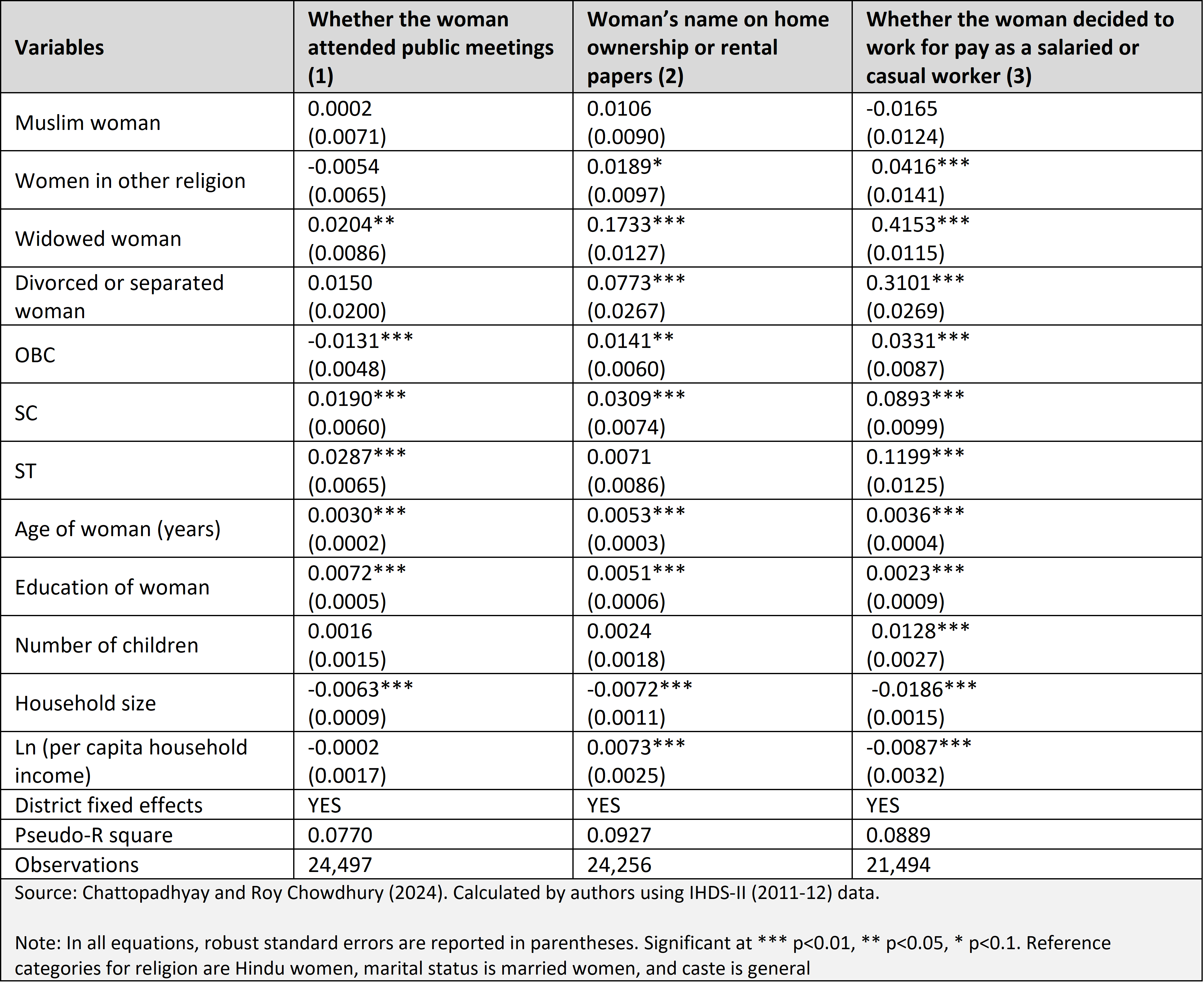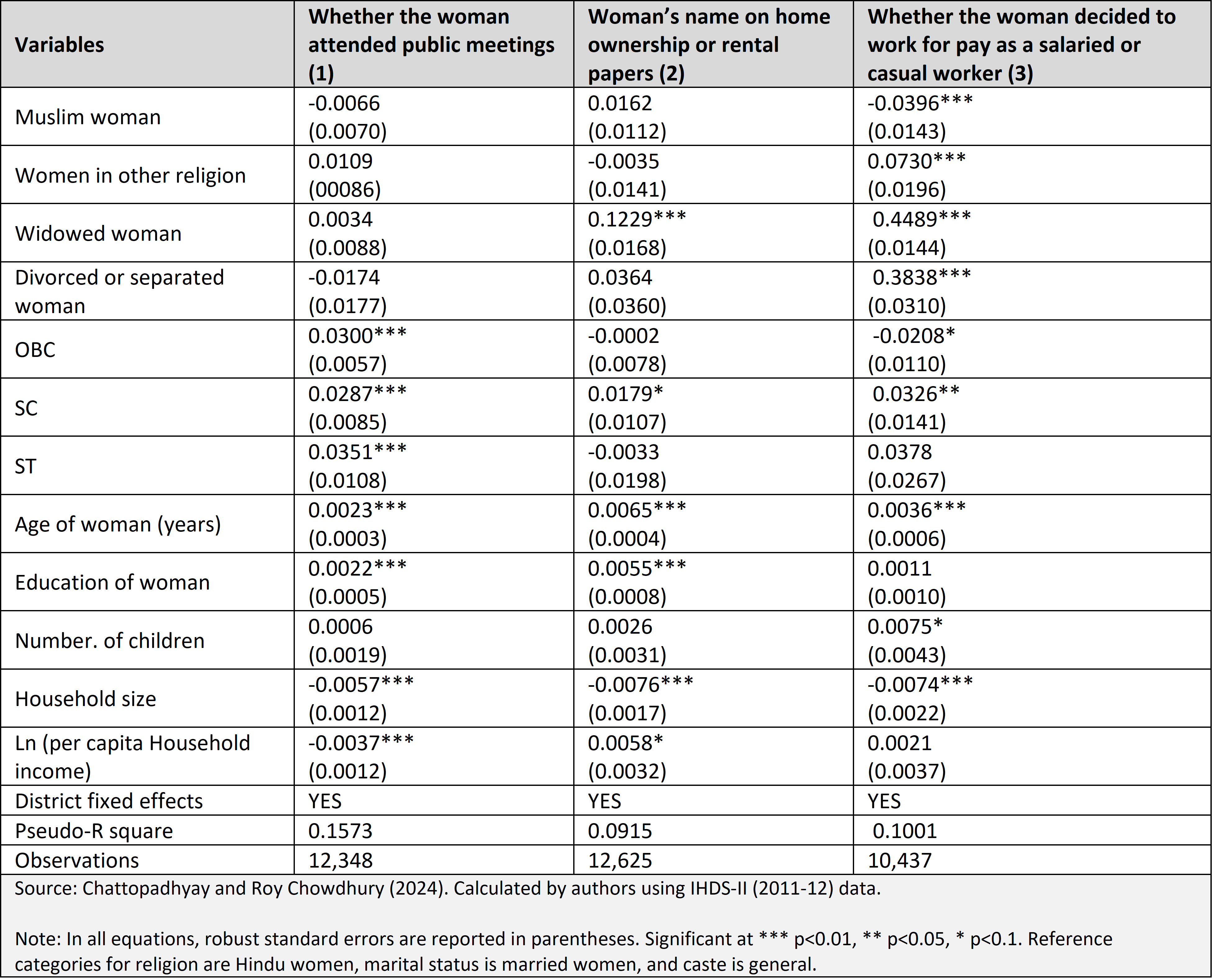Three states in India—Assam, Himachal Pradesh, and Uttarakhand—have recently passed legislation that governs the age of marriage either across all religions or specifically among Muslims. This has been done under the guise of gender justice and protection of girl children. Will this really bring about gender equity?
Our empirical analysis uses data from the Indian Human Development Survey II (2011-12) to examine whether women’s agency differs based on religion. Are Muslim women less likely to exert autonomy compared to their Hindu counterparts?
This is not the first time that the Indian state has passed legislation to govern conjugal relations with the purported aim of enhancing gender equality within domestic and public spaces. For instance, the state has enacted laws so that Hindu women can claim a share of their inheritance; it has criminalised domestic violence and sexual harassment at the workplace; and introduced reservations for women in gram panchayats. Notwithstanding these policies, gender disparities continue, according to the 2023 Global Gender Gap report.
Indian women fare poorly on health and survival, and persistently high levels of violence continue against them in the general and domestic spheres, as per the National Crime Records Bureau (Sriram 2023). This is likely to be an undercount because most instances of violence against women are not reported (Jacob and Chattopadhyay 2019). The government’s figures show there has been a 20% increase in reported crimes against women.
As instances in Uttar Pradesh, West Bengal, and other states have demonstrated, employment in the formal sector in even ostensibly respectable and feminised occupations, such as in hospitals, is unsafe for women workers.
More than 90% of female workers in India are employed in
Against this backdrop, the Indian state has decided to implement the Uniform Civil Code (UCC) arguing that it will put Indian women on the path to achieving gender parity. Uttarakhand’s enactment of the UCC might suggest that it is a crucial step to obtaining a more equitable and unified legal framework, as the objective is to establish a common set of laws for land and property inheritance, marriage, and divorce, regardless of religion. Many Hindu women have had legally enshrined rights to property for decades. But, for
An evidence-based public discussion is critical because debates around the UCC tend to be polarised, with supporters arguing in favour of eliminating discriminatory practices and providing equal rights to all citizens. In contrast, activists and scholars on the left of the political spectrum argue that the UCC could deny rights to religious minorities with no actual benefit to women in India (Menon 2014; Agnes 2016). They
Further, replacing religious and cultural diversity with one uniform code may not lead to a normative transformation because that requires time and the appropriate institutional arrangements to sustain such changes. Besides, each aspect of marriage, divorce, child adoption, and property inheritance should be considered separately to promote and sustain gender equality in each of these dimensions (Agarwal 2023).
…[W]omen’s employment on its own does not guarantee freedom from violence and oppression. The nature of employment and ownership of fixed assets are crucial in determining the contours of women’s autonomy.
Using data from the Indian Human Development Survey II of 2011-12, we have analysed differences in women’s autonomy by their religion on the basis of standard indicators such as women’s workforce participation rates, women’s mobility, and their freedom to take household decisions, choose healthcare options, and participate in the public sphere.
Our rationale for choosing these indicators is that women’s property ownership in the form of land, homes, or assets has major implications for their autonomy, including their ability to leave violent marriages (Agarwal and Panda 2007). Participation in paid employment is an important determinant of women’s social and economic empowerment, as it enhances their bargaining power inside and outside the household. However, women’s employment on its own does not guarantee freedom from violence and oppression. The nature of employment and ownership of fixed assets are crucial in determining the contours of women’s autonomy.
Women working outside their homes are more likely to participate in public and political affairs. Their involvement in public meetings can help develop networks, build support systems outside the marital family, and enhance the possibility of getting information from various sources. Finally, women’s ability to decide on their reproductive lives, healthcare (their’s and their children’s), the buying of important assets, and their expenses on social events are critical for a life that is meaningfully autonomous.
Results
According to Indian Human Development Survey II data, 83.9% of women in rural India are Hindus and 9.9% are Muslims. From Figure 1, using descriptive statistics, it may appear that Muslim women have less agency than Hindu women. However, most of these differences are not statistically significant; that is, they cannot be attributed to differences based on religion.
Nearly 9.3% of Hindu women and 8.6% of Muslim women participate in the public sphere in rural India. Relatively, more Hindu women (4.6%) report participating in work for pay than Muslim women (3.9%). However, this result needs to be interpreted by considering the systemic and systematic discrimination and exclusion that Muslim women encounter when trying to participate in the labour market because of deeply entrenched bias against their religious identity (Williams et al. 2017; Ledby Foundation 2022; Tabassum 2023). When it comes to property ownership, though relatively higher ownership rights exist for Hindu women than Muslim women, there is little difference.
Though the proportion of women holding property ownership rights is relatively high in urban India, the situation still needs improvement. Nearly 19.7% of urban Hindu women and 16.3% of urban Muslim women have property ownership rights.
In the urban Indian Human Development Survey II sample, 77.8% of women belong to the Hindu religion and 16.3% to the Muslim religion. Nearly 6.6% of Hindu and 4.7% of Muslim women reported having attended public meetings. As for paid work, 4.6% of Hindu women and 3.8% of Muslim women work as casual or salaried workers. Thus, in the context of labour market participation, the decision-making position of urban Hindu women appears to be better than that of Muslim women. It should be noted, however, that the workforce participation of Hindu women is
Though the proportion of women holding property ownership rights is relatively high in urban India, the situation still needs improvement. Nearly 19.7% of urban Hindu women and 16.3% of urban Muslim women have property ownership rights. In rural India, nearly 15.4% of Hindu women and 13% of Muslim women reported having their names on home ownership papers. Despite legal provisions for Hindu women, both Hindu and Muslim women lack ownership rights over property (Chattopadhyay and Roy Chowdhury 2024). This is important to note while discussing a UCC because laws may be necessary. But laws are by no means a sufficient condition to ensure gender equality on property rights.

There is not much difference in household decision-making about what to cook regularly in urban areas because 68.5% of Hindu and 68.4% of Muslim women reported they had such authority (Chattopadhyay and Roy Chowdhury 2024). This pattern is reversed when it comes to women’s participation in other decision-making domains. This includes decisions on the purchase of land or property, on how much to spend for weddings, on how many children to have, and on women’s healthcare. In all these cases, which make demands on the family budget, women have the least agency, irrespective of whether they are Hindu or Muslim.
Muslim women in urban India are less likely to work for pay outside the home compared to Hindu women, perhaps because of discriminatory labour market practices or personal preferences.
On the question of how many children to have, there is not much difference between Hindu and Muslim women. The results show that 24.8% of rural Hindu women and 23.4% of rural Muslim women can decide on the number of children to have. In urban India, 26.4% of Hindu women and 25.6% of Muslim women reported that they had a say in deciding how many children to have. Disconcertingly, regardless of their religion, husbands are making decisions for their wives even in situations where they run the risk of falling ill. Thus, women’s agency in crucial aspects of family decision-making remains low, and the differences across religious groups are not substantial (Chattopadhyay and Roy Chowdhury 2024).
Caste, Marital Status and Religion: What matters most?
In rural India, the likelihood of attending public meetings is the highest among widowed women and Scheduled Tribe (ST) women (Appendix Table A.1). We find that despite having legal rights to property ownership, few Hindu women have ownership rights over their houses. Muslim women are more likely than Hindu women to have their names on home ownership or rental papers, though the effect is statistically insignificant.
Widowed, divorced, or separated women, as well as women from Scheduled Caste (SC) communities, are more likely to have their names on ownership or rental papers. Women of these groups are more likely to work for pay as salaried or casual workers than married women. Across these indicators, SC and ST women are more likely to have attended public meetings, have their names on property documents, and opted to work for pay in rural India than women belonging to the higher castes.
For urban India (Appendix Table A.2), the results are similar to rural India—caste and marital status are more salient than religion. However, there is one difference. Muslim women in urban India are less likely to work for pay outside the home compared to Hindu women, perhaps because of discriminatory labour market practices or personal preferences. Further, women belonging to other religions are more likely than Hindu women to decide to work for pay as casual or salaried workers. Although the work status of Hindu women appears to be better than that of Muslim women, their remuneration rates need to be improved.
Conclusions
The dominant discourse seems to suggest that Muslim women, who are trapped in archaic Islamic patriarchal traditions such as the purdah, hijab, triple talaq, nikah halala, and others, lack autonomy in India, especially compared to their Hindu counterparts. This tends to overlook two critical facts. One, that 85% of Muslims in India are pasmanda Muslims; that is, they belong to Other Backward Castes, or SCs, or are tribal Muslims. Two, this implies that they live in conditions of greater poverty and other forms of economic and social privation compared to both upper-caste Muslims (ashrafs) and upper-caste Hindus (Azam 2023; Ansari 2019).
The discourse also elides the marginalisation and exclusion that Muslims encounter when accessing the labour market despite constitutional provisions of equality and non-discrimination.
What has deepened their hardships in recent times are actions such as the ban on cattle slaughter in several Indian states (Palliath 2022), evictions of Muslims for reasons ranging from development projects in Uttarakhand to “illegal” immigration in Assam, and biased and punitive actions for communal violence in Delhi (Siddiqui 2023). The discourse also elides the marginalisation and exclusion that Muslims encounter when accessing the labour market despite constitutional provisions of equality and non-discrimination. Article 14 of the Constitution guarantees equality before the law to all individuals, and Article 15 prohibits discrimination on grounds of gender, caste, or religion.
Our study is unequivocal that marital status and caste are the significant determinants of women’s agency in India, not religion, according to data from the Indian Human Development Survey II (2011-12). Surprisingly, education seems to matter very little, suggesting that it will take much more than degrees to transform gender norms in India to ensure greater equity. All Indian women, irrespective of their religion, lack agency in significant aspects of their lives.
We also want to iterate that while legal provisions such as ensuring access to ancestral property and the right to divorce, adopt, and marry a partner of one’s choice are necessary for women to exert agency, they alone are not sufficient. So, as promising as the UCC appears to be, whether it realises its lofty goals is wholly dependent on whether gender norms in the country change simultaneously.
Sreeparna Chattopadhyay is a Professor of Practice at the T.A. Pai Management Institute, Manipal University, and a visiting faculty member at Foundation for Liberal and Management Education (FLAME) University, Pune; and Joyita Roy Chowdhury is an Associate Professor in Economics at FLAME University, Pune.












